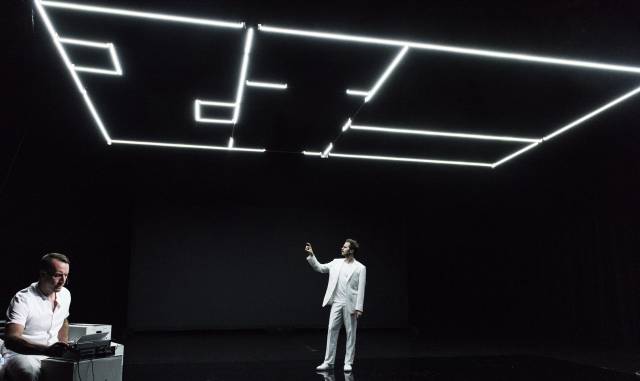

I went into Early Morning Opera's The Institute of Memory (TIMe), the captivating new play by Lars Jan, with two misconceptions. I’ll start with the first, which was swiftly and easily set to right and return to the second later on – I had been pronouncing the artist’s last name incorrectly. I had been saying Lars “Yahn” with a hard Scandinavian Y when, in fact, it is pronounced as it is spelled, with a J. Early on in this interesting play about personal history Sonny Valicenti delivers a monologue as Lars Henrik Jan that explains the myriad misdirections intentionally built into his given name by his mother and enigmatic father. Names are just one of the complicated signifiers of identity explored in (TIMe), currently playing at the Public Theater as part of the 2016 Under the Radar Festival. This multimedia performance shifts through time and genre in search of the story behind the artist’s mysterious father, Henryk (with a Y) Ryniewicz, a Cold War operative with an obsession for privacy and obfuscation.
The play follows two performers, Sonny Valicenti and Andrew Schneider, as they reenact archival wiretap transcriptions and communist spy communiqués, and exchange the role of Lars Jan. The duo is immediately dynamic. Both actors have a clear comedic sensibility while also bringing athletic rigor and sincerity to the many characters they portray over the course of this well-paced production. In addition to performing, Schneider, a skilled electronic artist who has taught courses on technology and performance at the NYU Tisch Interactive Telecommunications Program (ITP), also designed the “interactive typewriter,” which triggered synchronous sound and light to truly magical effect.
The set, described as a “kinetic light sculpture,” is a stunning construction of neon that bends and morphs throughout the performance. Pablo N. Molina, a creative code artist, designed the evocative video projections, which according to the play notes are “composed of medical scans, X-rays, etc. of Ryniewicz's body courtesy of Mass General Hospital, and laser scans of several actual environments where Jan spent time with his father as a child.” The video is a fine example of digital art that is clearly the product of vast data, processed through emerging software platforms to produce work that is aesthetically and emotionally moving.
This brings me back to my second misconception, the one that took the experience of watching this performance to overcome. I had previously seen Abacus, the Early Morning Opera piece presented at the 2015 BAM Next Wave Festival, also performed by Valicenti. After which I had developed the opinion that Jan’s work was technically impressive, theoretically interesting, but smacked of a certain macho theatrical style that intentionally distances the audience from the subject with a knowingly ironic over-confidence. Abacus, while smart, felt entrenched in the school of digital theater that is purposefully cold and hard to fully access. In (TIMe), Jan shares his family story with immense generosity while also embracing new tools and collaborators. The result is touching and innovative.
Performances of "The Institute of Memory (TIMe)" continue at Under the Radar through January 17.